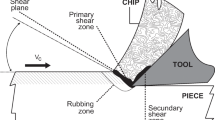Abstract
This paper presents a linear-quadratic regulator (LQR) approach for solving inverse heat conduction problems (IHCPs) arising in production processes like chip removing or drilling. The inaccessibility of the processed area does not allow the measuring of the induced temperature. Hence the reconstruction of the heat source based on given measurements at accessible regions becomes necessary. Therefore, a short insight into the standard treatment of an IHCP and the related LQR design is provided. The main challenge in applying LQR control to the IHCP is to solve the differential Riccati equation. Here, a model order reduction approach is used in order to reduce the system dimension. The numerical results will show the accuracy of the approach for a problem based on data given by practical measurements.








Similar content being viewed by others
References
Banks HT, Ito K (1991) A numerical algorithm for optimal feedback gains in high dimensional linear quadratic regulator problems. SIAM J Control Optim 29(3):499–515
Banks HT, Kunisch K (1984) The linear regulator problem for parabolic systems. SIAM J Control Optim 22:684–698
Benner P (1999) Computational methods for linear-quadratic optimization. Supplemento ai Rendiconti del Circolo Matematico di Palermo, Serie II No. 58:21–56
Benner P, Kürschner P, Saak J (2013) Efficient handling of complex shift parameters in the low-rank Cholesky factor ADI method. Numer Algorithms 62(2):225–251. doi:10.1007/s11075-012-9569-7
Benner P, Kürschner P, Saak J (2014) Self-generating and efficient shift parameters in ADI methods for large Lyapunov and Sylvester equations. Electron Trans Numer Anal 43:142–162
Benner P, Li JR, Penzl T (2008) Numerical solution of large Lyapunov equations, Riccati equations, and linear-quadratic control problems. Numer Linear Algebra Appl 15(9):755–777
Benner P, Mena H (2012) Numerical solution of the infinite-dimensional LQR-problem and the associated differential Riccati equations. Preprint MPIMD/12-13, MPI Magdeburg Preprint. http://www.mpi-magdeburg.mpg.de/preprints/
Benner P, Mena H (2013) Rosenbrock methods for solving Riccati differential equations. IEEE Trans Autom Control 58(11):2950–2957
Bonesky D, Dahlke S, Maass P, Raasch T (2010) Adaptive wavelets methods and sparsity reconstruction for inverse heat conduction problems. Adv Comput Math 33(4):385–411
Enns DF (1984) Model reduction with balanced realizations: an error bound and a frequency weighted generalization. 23rd IEEE Conf Decis Control 23:127–132
Grossmann C, Roos HG, Stynes M (2007) Numerical treatment of partial differential equations. Springer, Berlin
Hairer E, Wanner G (2002) Solving ordinary differential equations II: stiff and algebraic problems, 2nd edn. Springer, Berlin, Heidelberg
Kindermann S, Navasca C (2006) Optimal control as a regularization method for ill-posed problems. J Inverse Ill-Posed Probl 14:685–703
Lamm PK (1996) Future-sequential regularization methods for ill-posed Volterra equations. J Math Anal Appl, 469–494
Lang N, Mena H, Saak J (2014) An \(LDL^T\) factorization based ADI algorithm for solving large scale differential matrix equations. Proc Appl Math Mech 14(1):827–828
Li JR, White J (2002) Low rank solution of Lyapunov equations. SIAM J Matrix Anal Appl 24(1):260–280
Locatelli A (2001) Optimal control: an introduction. Birkhäuser, Basel
Louis AK (1989) Inverse und schlecht gestellte Probleme. Teubner, Stuttgart
Moore BC (1981) Principal component analysis in linear systems: controllability, observability, and model reduction. IEEE Trans Autom Control AC–26(1):17–32
Neugebauer R, Drossel WG, Ihlenfeldt S, Richter C (2012) Thermal interactions between the process and workpiece. Procedia CIRP, 63–66. doi:10.1016/j.procir.2012.10.012
Penzl T (2000) A cyclic low rank Smith method for large sparse Lyapunov equations. SIAM J Sci Comput 21(4):1401–1418
Penzl T (2000) Eigenvalue decay bounds for solutions of Lyapunov equations: the symmetric case. Syst Control Lett 40:139–144
Penzl T (2006) Algorithms for model reduction of large dynamical systems. Linear Algebra Appl 415(2–3):322–343 (Reprint of Technical Report SFB393/99-40, TU Chemnitz, 1999.)
Schindler S, Zimmermann M, Aurich JC, Steinmann P (2014) Finite element model to calculate the thermal expansions of the tool and the workpiece in dry turning. Procedia CIRP 14:535–540
Schindler S, Zimmermann M, Aurich JC, Steinmann P (2014) Thermo-elastic deformations of the workpiece when dry turning aluminum alloys: a finite element model to predict thermal effects in the workpiece. CIRP J Manuf Sci Technol 7:233–245. doi:10.1016/j.cirpj.2014.04.006
Schweinoch M, Joliet R, Kersting P (2014) Predicting thermal loading in nc milling processes. Prod Eng. doi:10.1007/s11740-014-0598-z
Strauss WA (2008) Partial differential equations: an introduction. Brown University, Whiley
Acknowledgments
This research was funded by the Deutsche Forschungsgemeinschaft (DFG) within the Collaborative Research Center/Transregio 96 Thermo-Energetic Design of Machine Tools.
Author information
Authors and Affiliations
Corresponding author
Rights and permissions
About this article
Cite this article
Lang, N., Saak, J., Benner, P. et al. Towards the identification of heat induction in chip removing processes via an optimal control approach. Prod. Eng. Res. Devel. 9, 343–349 (2015). https://doi.org/10.1007/s11740-015-0608-9
Received:
Accepted:
Published:
Issue Date:
DOI: https://doi.org/10.1007/s11740-015-0608-9



